If you're looking for natural ways to relieve headaches, herbal teas can be a great option. Peppermint tea relaxes muscles and improves circulation. Ginger tea fights nausea and inflammation. Chamomile tea soothes tension and promotes relaxation. Lavender can calm your mind, easing stress-related headaches. Willow bark tea is like nature's aspirin, helping with pain relief. Basil tea reduces inflammation, while lemon balm helps with stress. Hibiscus tea supports blood pressure management, and green tea provides antioxidant benefits. Each variety offers unique advantages, and there's so much more you can explore to find your perfect remedy.
Peppermint Tea Benefits

When it comes to finding relief from headaches, the invigorating properties of peppermint tea can be a game changer. This aromatic beverage not only tastes great but also offers several benefits that can help ease your discomfort.
When you sip on peppermint tea, you're tapping into the natural analgesic and anti-inflammatory properties of peppermint oil, which can help relax your muscles and soothe tension headaches.
Inhaling the steam from a hot cup of peppermint tea can provide additional relief, as the menthol in peppermint acts as a natural decongestant. If your headache is accompanied by sinus issues, this can be particularly beneficial.
You'll also appreciate how peppermint tea helps improve circulation, which can alleviate pain and promote overall relaxation.
Moreover, drinking peppermint tea can help reduce stress and anxiety, both of which are common headache triggers. By taking a moment to brew and enjoy a warm cup, you're giving yourself a chance to unwind.
Ginger Tea for Nausea
Ginger tea is a powerful remedy for nausea that you can easily incorporate into your routine.
It not only helps soothe your stomach but also offers various health benefits.
Let's explore how to prepare ginger tea, the ideal dosage, and some helpful usage tips.
Benefits of Ginger Tea
Many people turn to ginger tea for its powerful nausea-relieving properties. It's not just a remedy for an upset stomach; this aromatic brew offers various benefits that can make you feel better in no time.
Here are three key advantages of drinking ginger tea that you should know:
- Reduces Motion Sickness: If you're prone to motion sickness, sipping ginger tea can help soothe your stomach and reduce that queasy feeling during travel.
- Eases Morning Sickness: For expectant mothers, ginger tea is a natural option to alleviate morning sickness. Its anti-nausea effects can provide relief when you need it most, making your pregnancy journey a bit smoother.
- Aids Digestion: Ginger tea promotes healthy digestion by stimulating saliva and bile production. This can help you feel more comfortable after meals, especially if you're experiencing bloating or indigestion.
Incorporating ginger tea into your routine can help you combat nausea effectively while providing these additional benefits.
How to Prepare
To prepare ginger tea for nausea relief, start by gathering fresh ginger root, water, and optional flavorings like honey or lemon.
Peel about one to two inches of ginger root and slice it into thin pieces or grate it for a stronger flavor.
Next, bring four cups of water to a boil in a saucepan. Once boiling, add the ginger pieces to the water.
Let it simmer for about 10 to 15 minutes, depending on how strong you want the tea. The longer you steep, the more intense the flavor will be.
After simmering, remove the saucepan from heat and strain the tea into a cup using a fine mesh strainer to get rid of the ginger pieces.
If you like, you can add honey for sweetness or a squeeze of lemon for a revitalizing twist.
Stir well and let it cool slightly before sipping. Enjoy your ginger tea warm to soothe nausea effectively.
You can also prepare larger batches and store them in the refrigerator for later use, reheating as needed.
Dosage and Usage Tips
While sipping on ginger tea can be an effective remedy for nausea, knowing the right dosage is crucial for maximizing its benefits. Start with a moderate approach, especially if you're new to ginger. Here are some dosage tips to take into account:
- Frequency: Aim for 2 to 3 cups of ginger tea daily. This frequency allows your body to absorb the ginger's properties without overwhelming your system.
- Serving Size: Use about 1 to 2 teaspoons of fresh ginger root per cup of water. If you're using ginger tea bags, one bag per cup should suffice. This guarantees you get enough ginger to combat nausea effectively.
- Timing: Drink ginger tea before meals or at the onset of nausea. This way, you can help settle your stomach and prevent further discomfort.
Chamomile Tea Soothing Effects
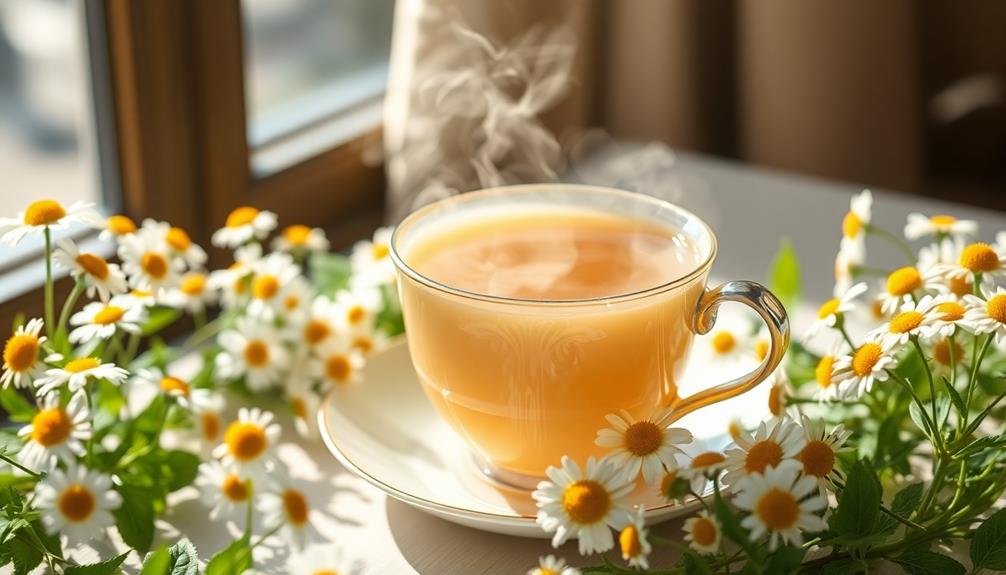
Chamomile tea's anti-inflammatory properties can really help ease your headache discomfort.
Its calming aroma not only relaxes your mind but also promotes a soothing experience.
You might find that sipping this tea offers you the relief you need after a long day.
Anti-inflammatory Properties Explained
The soothing effects of chamomile tea can be attributed to its impressive anti-inflammatory properties. When you sip on this aromatic beverage, you're not just enjoying a warm drink; you're also benefiting from its ability to reduce inflammation in your body, which can be a key factor in alleviating headaches.
Here are three ways chamomile tea works its magic:
- Rich in Antioxidants: Chamomile contains antioxidants like apigenin that help combat oxidative stress, which can lead to inflammation and pain.
- Muscle Relaxation: The natural compounds in chamomile can help relax muscles, easing tension that often contributes to headaches, especially tension headaches.
- Immune Support: By reducing inflammation, chamomile tea can support your immune system, helping your body fight off infections or illnesses that might trigger headaches.
Incorporating chamomile tea into your daily routine can be a simple yet effective way to harness its anti-inflammatory benefits.
Calming Aroma Benefits
With its gentle, floral aroma, chamomile tea creates an inviting atmosphere that promotes relaxation and calmness. When you're feeling the weight of a headache, this soothing scent can work wonders. As you brew a cup, take a moment to inhale the warm steam; the calming notes can help ease tension and anxiety.
Chamomile tea contains compounds that interact with your brain's receptors, providing a natural sedative effect. This can lead to a reduction in stress, which often triggers headaches. By sipping on this aromatic tea, you're not just hydrating; you're also allowing your mind and body to unwind.
As you settle in with your chamomile tea, you may notice a subtle shift in your mood. Its calming properties can help you find peace in a hectic day, making it an ideal companion for those moments when stress seems overwhelming.
Incorporating chamomile tea into your routine can serve as a simple yet effective way to manage headaches. So next time you feel a headache creeping in, brew a cup of chamomile and let its soothing aroma work its magic. You'll be glad you did.
Lavender Tea Relaxation Properties
Lavender tea is renowned for its soothing properties, making it a go-to remedy for relieving headaches and promoting relaxation. When you sip on this fragrant brew, you're not just enjoying a delightful taste; you're also embracing a sense of calm that can help alleviate the stress that often triggers headaches.
Here are three key benefits of lavender tea that contribute to its relaxation properties:
- Aromatherapy Effects: The calming scent of lavender has been shown to reduce anxiety and promote a tranquil mindset. This can be especially helpful when you're feeling overwhelmed.
- Muscle Relaxation: Lavender tea has natural muscle-relaxing qualities. Drinking it may help ease tension in your neck and shoulders, which can often be the culprits behind tension headaches.
- Sleep Aid: If headaches are disrupting your sleep, lavender tea can help. Its gentle sedative effects can improve your sleep quality, leading to fewer headaches caused by fatigue.
Incorporating lavender tea into your routine can be a simple yet effective way to combat headaches while enhancing your overall relaxation.
Willow Bark Tea Uses
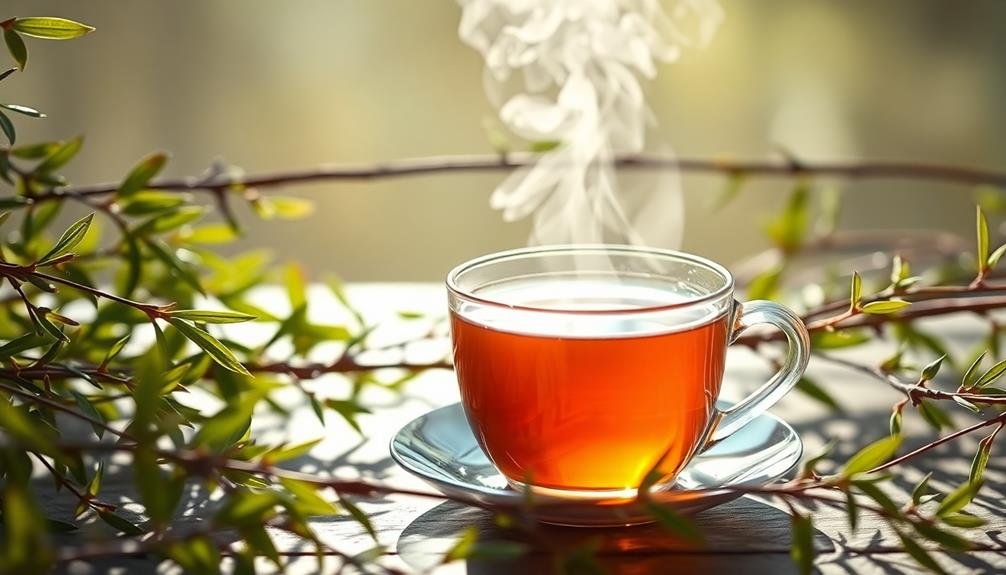
Willow bark tea has gained popularity as a natural remedy for various ailments, particularly headaches. This herbal tea contains salicin, a compound that your body converts into salicylic acid, the active ingredient in aspirin. When you sip on willow bark tea, you might find it effective in alleviating headache pain and reducing inflammation.
In addition to headaches, willow bark tea can help with back pain, arthritis, and other inflammatory conditions. If you're experiencing muscle soreness or joint discomfort, drinking this tea may provide the relief you need.
It's also known for its calming properties, which can help reduce stress and tension that often accompany headaches.
To prepare willow bark tea, simply steep the dried bark in hot water for about 10 to 15 minutes. Sweeten it with honey or lemon if you prefer. Remember to start with a small amount to see how your body reacts, as it can interact with certain medications and may not be suitable for everyone.
Including willow bark tea in your natural remedy arsenal can be a good way to manage headache symptoms and discomfort, offering you a herbal alternative to over-the-counter pain relievers.
Feverfew Tea for Prevention
Feverfew has a long history as a natural remedy for headaches and migraines.
To get the most out of this herbal tea, you'll want to know how to prepare it properly and enjoy it regularly.
Let's explore its traditional uses and the best ways to brew and consume feverfew tea for effective prevention.
Historical Use of Feverfew
For centuries, herbalists have turned to feverfew as a trusted remedy for headache prevention. This herb, scientifically known as Tanacetum parthenium, has roots in ancient Greece, where Hippocrates recommended it for various ailments, including migraines.
You might be surprised to learn that feverfew's popularity has endured through the ages, thanks to its effectiveness and the growing body of anecdotal evidence supporting its benefits.
When considering feverfew for headache relief, keep in mind these historical highlights:
- Traditional Use: Ancient herbalists often prepared feverfew in teas and tinctures, believing it could ward off headaches before they even started.
- Cultural Significance: In medieval Europe, feverfew was valued not just for headache prevention but also for its role in promoting general well-being, making it a staple in many households.
- Modern Endurance: Today, feverfew remains a popular choice among those seeking natural alternatives for headache relief, reflecting its long-standing reputation.
Preparation and Consumption Methods
When looking to harness the benefits of feverfew for headache prevention, preparing and consuming it as a tea is a popular method. To make feverfew tea, you'll need dried feverfew leaves, which you can find at health food stores or online.
Start by boiling about two cups of water in a pot. Once it's boiling, turn off the heat and add one to two teaspoons of dried feverfew leaves. Let the leaves steep for about 10 to 15 minutes. This allows the beneficial compounds to infuse into the water.
After steeping, strain the tea to remove the leaves. If you find the taste too bitter, you can mix in honey, lemon, or another natural sweetener to enhance the flavor.
It's best to consume the tea regularly for ideal results. Aim for one to two cups per day for headache prevention.
Remember to consult with your healthcare provider before starting any new herbal regimen, especially if you're pregnant, nursing, or on medication.
With consistent consumption, feverfew tea can be a simple yet effective way to help keep headaches at bay.
Basil Tea Anti-inflammatory Effects
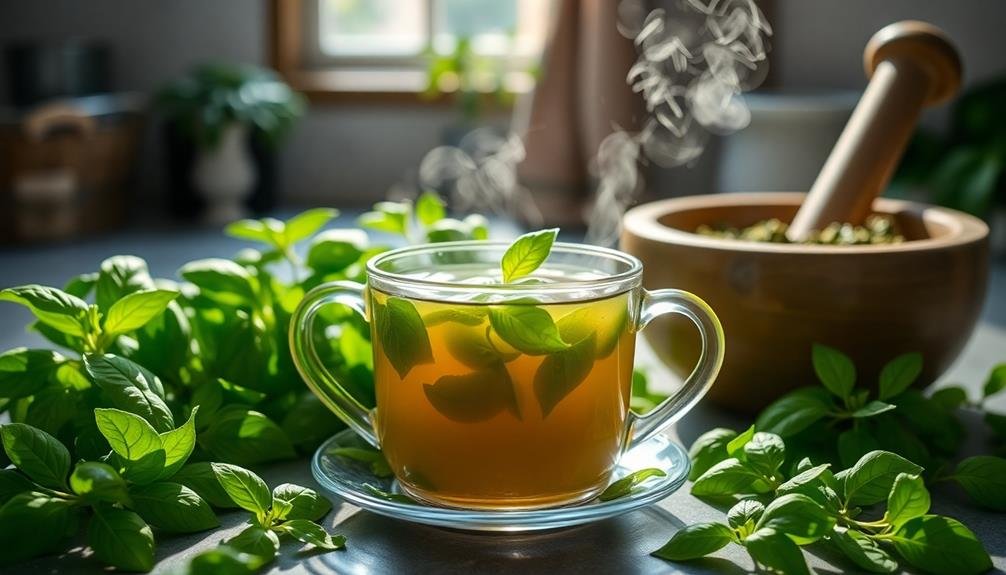
Basil tea often provides notable anti-inflammatory effects that can help alleviate headaches. The compounds found in basil, such as eugenol, work to reduce inflammation in your body, which can be a major contributor to headache pain.
When you sip on this soothing tea, you're not just enjoying a comforting beverage; you're also supporting your body's natural healing processes.
Here are three reasons why basil tea is an excellent choice for headache relief:
- Reduces Inflammation: The anti-inflammatory properties of basil can target the root causes of headaches, helping to ease tension and discomfort.
- Enhances Relaxation: Basil tea can promote relaxation and calm your mind, which is essential when you're dealing with a headache. A more relaxed state can lead to a decrease in headache intensity.
- Supports Overall Health: By incorporating basil tea into your routine, you're also benefiting from its antioxidants and essential vitamins, which support your immune system and overall well-being.
Lemon Balm Tea Comfort
Lemon balm tea offers a gentle comfort that can be especially soothing when you're struggling with a headache. This herbal infusion is known for its calming properties, making it a perfect choice when stress or tension triggers your pain. As you sip on this fragrant tea, you might notice a subtle sense of relaxation washing over you, easing both your mind and body.
Rich in antioxidants, lemon balm can help reduce inflammation and promote overall wellness. The mild lemony flavor adds a revitalizing element, making it enjoyable to drink. You can brew it using fresh or dried leaves, and it works well either hot or iced, depending on your preference.
To enhance its effects, consider adding a touch of honey or a slice of lemon. Both can amplify the soothing qualities, while also providing additional relief.
As you take the time to enjoy your lemon balm tea, focus on your breathing. Deep, steady breaths can further help alleviate headache symptoms.
Hibiscus Tea for Blood Pressure
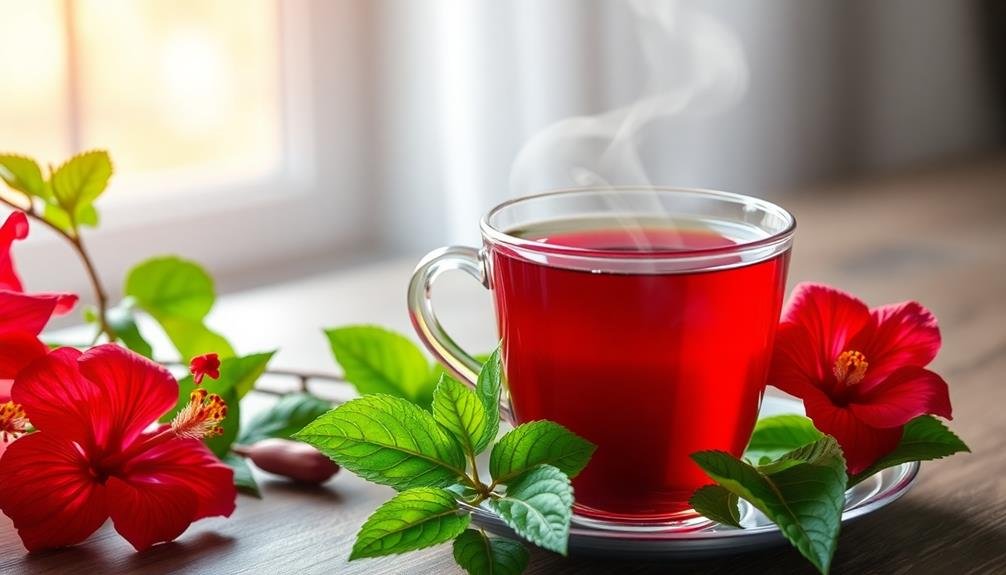
Hibiscus tea stands out as a powerful ally for those looking to manage blood pressure effectively. This vibrant, tart brew isn't just invigorating; it also offers significant health benefits. Research suggests that regularly consuming hibiscus tea may help lower both systolic and diastolic blood pressure, making it a great addition to your daily routine.
Here are three reasons you should consider hibiscus tea for blood pressure management:
- Rich in Antioxidants: Hibiscus is packed with antioxidants, which can help combat oxidative stress and lower blood pressure levels.
- Natural Diuretic: This tea acts as a natural diuretic, helping your body eliminate excess sodium and fluid, further supporting healthy blood pressure.
- Easy to Prepare: Brewing hibiscus tea is simple! Just steep dried hibiscus flowers in hot water for 5-10 minutes, sweeten if desired, and enjoy either hot or iced.
Incorporating hibiscus tea into your daily routine could be a sweet and tangy way to support your heart health.
Just remember to consult with your healthcare provider, especially if you're on medication for blood pressure. Enjoy your tea time!
Green Tea Antioxidant Benefits
While many beverages claim health benefits, green tea consistently stands out due to its remarkable antioxidant properties. You might be familiar with the term "antioxidants," but let's explore why they matter for your overall health.
Green tea is rich in catechins, a type of antioxidant that helps combat free radicals in your body. These free radicals can contribute to cellular damage and lead to chronic illnesses.
Drinking green tea regularly can enhance your body's ability to fight inflammation and may even lower your risk of certain diseases, including heart disease and cancer.
When you're experiencing a headache, the anti-inflammatory effects of green tea can provide soothing relief, helping to alleviate discomfort.
In addition, the caffeine present in green tea can act as a mild stimulant, which can help improve alertness and reduce headache symptoms for some individuals.
If you enjoy a warm cup of green tea, you're not just treating yourself to a delicious beverage, but you're also supporting your body's defenses with powerful antioxidants.
Frequently Asked Questions
How Long Does It Take for Herbal Tea to Relieve Headaches?
It usually takes about 30 minutes to an hour for herbal tea to relieve headaches. You'll feel the effects as the herbs work, but individual responses can vary based on your body and the specific tea used.
Can I Combine Different Herbal Teas for Headache Relief?
Yes, you can combine different herbal teas for headache relief. Mixing ingredients like peppermint and chamomile might enhance their effects. Just make certain you're aware of any potential interactions, and listen to your body's response.
Are There Any Side Effects of Herbal Teas for Headaches?
Yes, herbal teas can cause side effects like allergic reactions, digestive issues, or interactions with medications. It's crucial to monitor how your body responds and consult a healthcare professional if you experience any adverse effects.
How Often Can I Drink Herbal Tea for Headaches?
You can drink herbal tea for headaches multiple times a day, but it's best to listen to your body. Start with one to two cups daily and adjust based on how you feel.
Should I Consult a Doctor Before Using Herbal Teas for Headaches?
If you're considering herbal teas for headaches, it's wise to consult a doctor first. They can guide you on safety, potential interactions, and effectiveness, ensuring you make the best choice for your health.
In Summary
Incorporating these herbal teas into your routine can offer you natural relief from headaches. Each tea brings its unique benefits, whether it's peppermint's invigorating properties or ginger's nausea-fighting power. By exploring these options, you can find the perfect blend that suits your needs. So next time you feel a headache coming on, brew a cup of one of these soothing teas, and enjoy the comforting relief they provide. Cheers to your health and well-being!

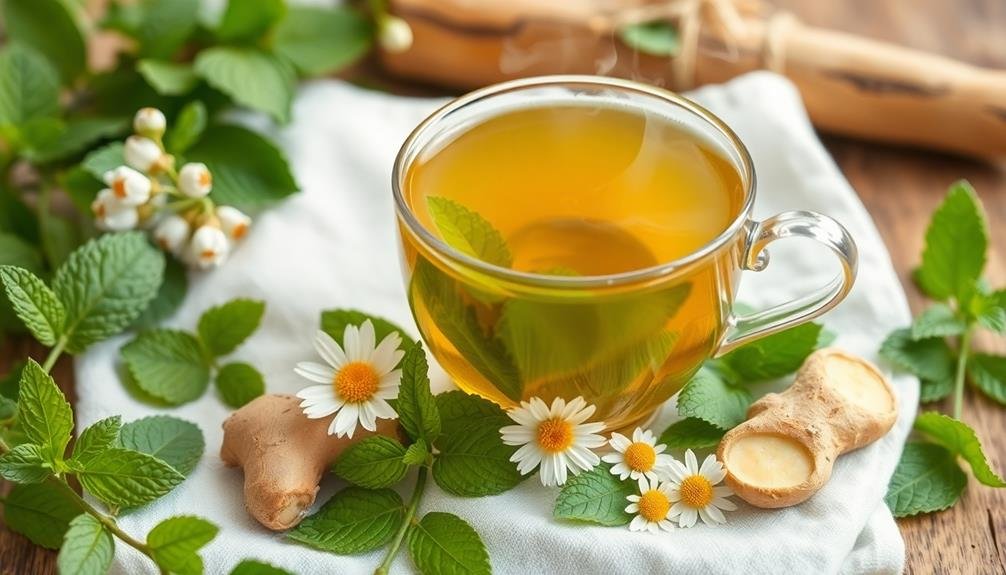

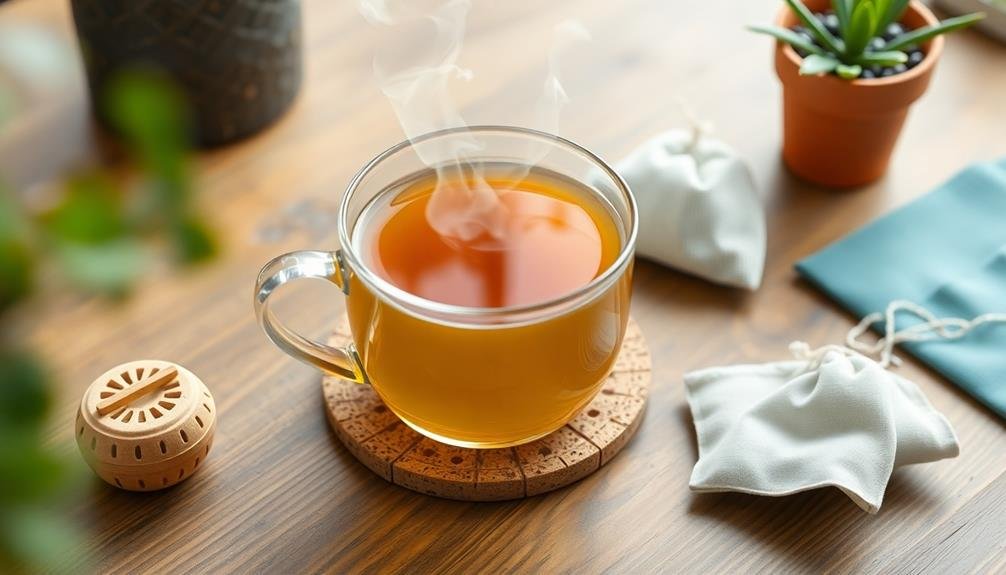

Leave a Reply